Last year we had Jennifer Lawrence as the queen of the QVC shopping channel in Joy. For 2017, here’s Michael Keaton as Ray Kroc, a struggling travelling salesman who went on to become the driving force behind the McDonald's fast-food empire. I’m looking forward to seeing George Clooney as Colonel Sanders.

You must remember this. It’s December 1941, the month of Pearl Harbour. Richard Blaine (Humphrey Bogart), an American, probably a Communist, who fought Franco in Spain and ran guns to Ethiopia when Mussolini invaded, has given up the fight against fascism and become the proprietor of Rick’s Café Américain, a casino-nightclub in Casablanca, in unoccupied French Morocco.

What’s love all about anyway? That’s the almost certainly unanswerable question that Israeli-American director Alma Har’el sets out to tackle in her strange, feverish, at times downright hallucinatory documentary LoveTrue. The problem is, by the end of its alternately entertaining and disconcerting 80 minutes, you’ll almost certainly be none the wiser. And you may even have forgotten what the original question was anyway.
Har’el’s previous documentary Bombay Beach, on a ruined ghost town in southern California, earned high praise for its fantastical visuals and its blurring of reality and fiction. She takes a similar approach here, but to a far less effective end. LoveTrue is undeniably striking in its weird imagery and its free-flowing structure, but whether it ever really engages with its theme is another matter entirely.
Har’el’s romantic investigations focus on three relationships from the furthest corners of the US. Alaskan self-confessed "nerd girl" Blake gets a lot of self-confidence from being a stripper in a lap-dancing club, she says, but she’s worried her boyfriend, who has a rare and debilitating bone condition, is drifting away from her. Hawaiian surfer dude Coconut Willie – who scrapes a living from shinning up coconut trees to retrieve their fruit – discovers that the infant he’s raising is not his son, but rather the son of his petulant ex-girlfriend and best mate. And in New York, the gospel-singing (and they do it brilliantly) Boyd family are still reeling from their mother’s sudden departure, with husband John offering his own pseudo-philosophical understandings of what their romantic problems were.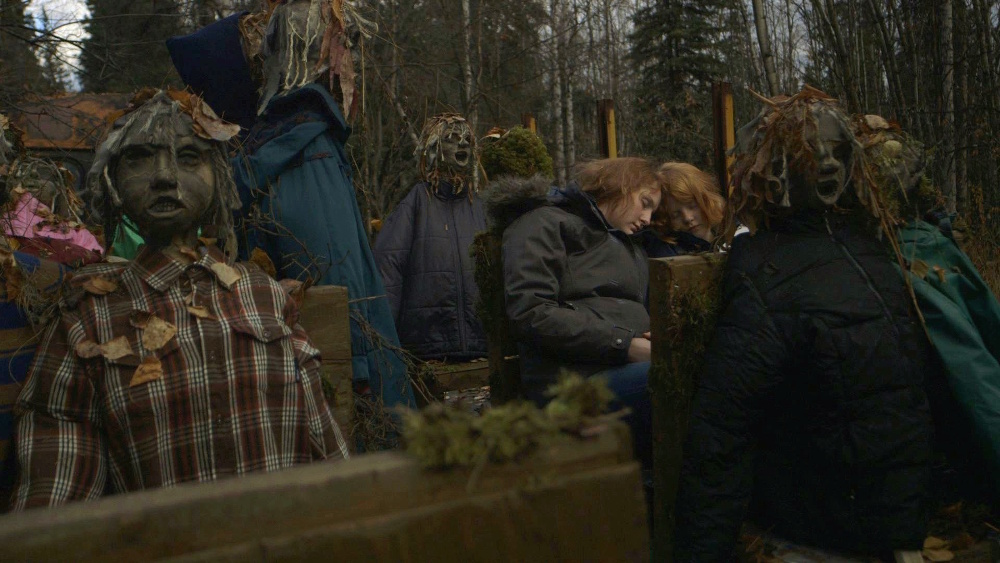 There are intriguing, contrasting perspectives on love here – and on the consequences when it breaks down. But Har’el seems reluctant to trust her subjects’ stories much, or even to tell them in a particularly clear or straightforward way. Instead, she seems to want to get inside her protagonists’ heads, to see the world from their individual perspectives – which might not give us many insights into love, even if it makes for some unforgettable visuals.
There are intriguing, contrasting perspectives on love here – and on the consequences when it breaks down. But Har’el seems reluctant to trust her subjects’ stories much, or even to tell them in a particularly clear or straightforward way. Instead, she seems to want to get inside her protagonists’ heads, to see the world from their individual perspectives – which might not give us many insights into love, even if it makes for some unforgettable visuals.
And when it works, Har’el’s dream-like sense of flow from scene to scene is a marvellous thing. As in an elegant segue from the pulsing Northern Lights to the gaudy neon of a cruddy Alaskan lap-dancing club. Or a downright creepy staging of a horrible bullying incident from Blake’s childhood, re-enacted on a bus lost in the woods that’s populated with sinister lifeless dummies (pictured above). Har’el’s blurring of fact and fiction, though not a new trick, is one of the film’s most fascinating conceits – and also one of its most troublesome. It’s fine when we know what we’re watching isn’t real – as in Willie’s elaborately choreographed underwater skirmish with (supposedly) his love rival (pictured above), which his story builds to. But at other times, truth and fictions are considerably less easy to tell apart – as in New Yorker John’s strange appearance on a cable TV channel, expounding his theories on love.
Har’el’s blurring of fact and fiction, though not a new trick, is one of the film’s most fascinating conceits – and also one of its most troublesome. It’s fine when we know what we’re watching isn’t real – as in Willie’s elaborately choreographed underwater skirmish with (supposedly) his love rival (pictured above), which his story builds to. But at other times, truth and fictions are considerably less easy to tell apart – as in New Yorker John’s strange appearance on a cable TV channel, expounding his theories on love.
LoveTrue is a film that wears its artifice proudly. It not only employs actors to play the younger and older versions of its main protagonists – signposting them with "Older Blake" or "Younger Willie" T-shirts – but also goes further in giving voice to those actors themselves, even allowing them conversations with the figures they’re meant to be playing. It’s all a bit head-turningly meta. But again, when it works, it’s a treat: arguably the film’s best thing is Snow (pictured below with Blake), the 49-year-old stripper drafted in to play an ageing Blake, but who soon takes on life in her own right to admit – heartbreakingly – that she’s no idea where her life is going.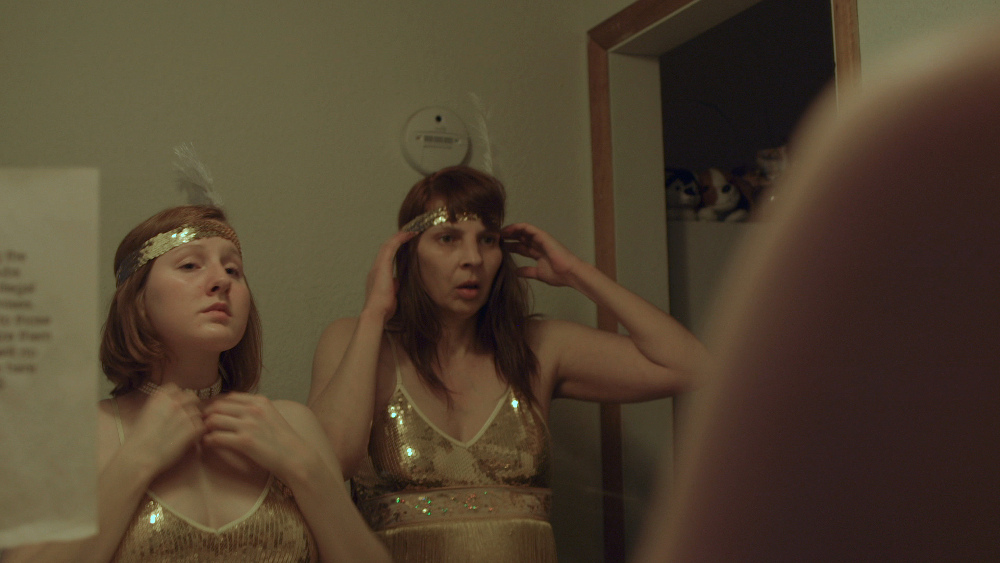 But for all the visual cleverness, the garish colours and the dreamlike connections, the stories Har’el is telling just don’t end up seeming that interesting – or at least she doesn’t probe them strongly enough to discover much empathy. By the end of LoveTrue, we don’t get to know (and therefore care) much about any of her trio of protagonists – are they there simply because they’re a bit kooky? In any case, Har’el doesn’t seem compelled enough by them to tell their stories simply and sincerely, other than as a framework for her own unbridled imagination. LoveTrue is a thoroughly entertaining and stylish 80 minutes of cinema, but whether it shines any new light on one of life’s great mysteries – well, that’s another matter entirely.
But for all the visual cleverness, the garish colours and the dreamlike connections, the stories Har’el is telling just don’t end up seeming that interesting – or at least she doesn’t probe them strongly enough to discover much empathy. By the end of LoveTrue, we don’t get to know (and therefore care) much about any of her trio of protagonists – are they there simply because they’re a bit kooky? In any case, Har’el doesn’t seem compelled enough by them to tell their stories simply and sincerely, other than as a framework for her own unbridled imagination. LoveTrue is a thoroughly entertaining and stylish 80 minutes of cinema, but whether it shines any new light on one of life’s great mysteries – well, that’s another matter entirely.

Fences is one of the best-known works by playwright August Wilson, part of his Century Cycle of plays exploring 100 years of black American history, and it won him a Pulitzer Prize and a Tony Award in 1987. Wilson died in 2005, but further gongs greeted the play’s 2010 Broadway revival, including Tonys for its stars Denzel Washington and Viola Davis.

Travis Bickle’s Manhattan is long gone, and except for those nostalgic for its grindhouses and their exploitation fare, few surely regret its passing. It’s been years since any modern-day Travis could cruise in a yellow taxi along the erstwhile “Deuce” - the squalid stretch of porn emporia and strip clubs on West 42nd Street - turn north up Eighth Avenue to the high forties and accurately observe, “All the animals come out at night - whores, skunk pussies, buggers, queens, fairies, dopers, junkies, sick, venal. Someday a real rain will come and wash all this scum off the streets.” The rain - a reference to the Deluge - did come. After a decade of planning, the gentrification of Hell’s Kitchen (and Disneyfication of The Deuce) was effectively completed during Rudolph W Giuliani’s mayoralty in the Nineties, though some of the porn shops and strip clubs simply migrated a few blocks away.
No matter that Taxi Driver (1976, back out as a re-release from Park Circus this week) has the semblance of a dream, much of what Martin Scorsese shot for it was documentary footage. There was misery in its making. “I’m telling you, 42nd Street, Eighth Avenue, that was hell, shooting in those places,” he tells Richard Schickel in the book Conversations with Scorsese. “That was, like, biblical in my mind, Hell and damnation and Jeremiah… I didn’t enjoy shooting in those X-rated areas. The sense of wallowing in it was, for me, always filled with tension and extraordinary depression. And the film is very, very depressing.”
Sociopaths invariably find excuses for their rage, but a cultural artefact cannot be held responsible
To David Thompson and Ian Christie, editors of Scorsese on Scorsese, he said, “We shot the film during a very hot summer and there’s an atmosphere at night that’s like a seeping kind of virus. You can smell it in the air and taste it in your mouth. It reminds me of the scene in The Ten Commandments portraying the killing of the first born, where a cloud of green smoke seeps along the palace floor and touches the foot of a first-born son, who falls dead. That’s almost what it’s like: a strange disease creeps along the streets of the city and, while we were shooting the film, we would slide along after it. Many times people threatened us and we had to take off quickly.”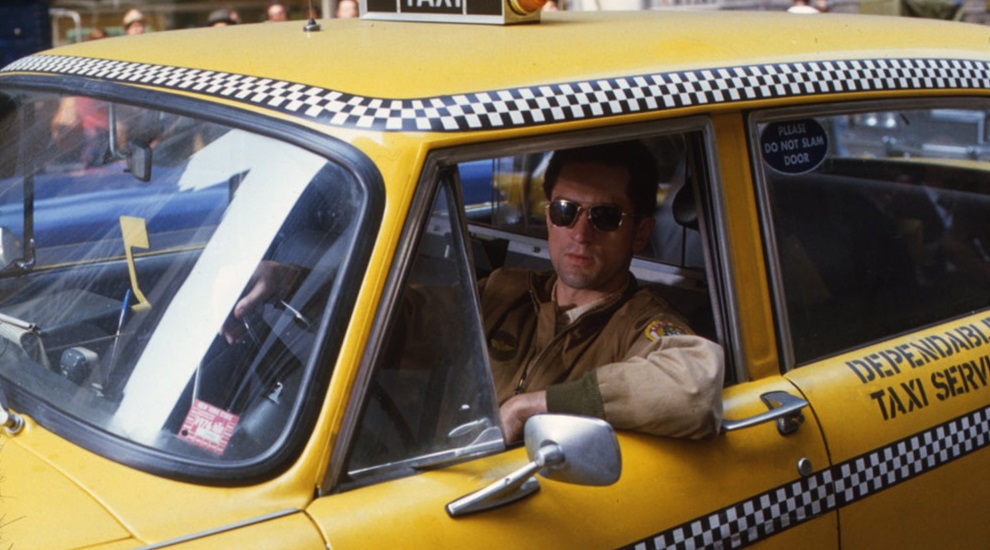 Living in Hell’s Kitchen in the late Eighties, I collected my own set of memories: a waif-like teen prostitute flagging down trucks outside my apartment house on 46th Street each lunchtime for weeks on end; spent condoms in the gutters; being stalked by the six-foot hustler I rebuffed on 42nd the only time I walked down the street at 1am. Hundreds of mentally ill and homeless people lived locally. It wasn’t simply a red-light district; it was a well of illness and pain.
Living in Hell’s Kitchen in the late Eighties, I collected my own set of memories: a waif-like teen prostitute flagging down trucks outside my apartment house on 46th Street each lunchtime for weeks on end; spent condoms in the gutters; being stalked by the six-foot hustler I rebuffed on 42nd the only time I walked down the street at 1am. Hundreds of mentally ill and homeless people lived locally. It wasn’t simply a red-light district; it was a well of illness and pain.
That late-noir miasma lives on indelibly in Scorsese’s masterpiece, though for all its actuality it acquired a mythic aura in a way that other searing films depicting contemporary necropoli have not, among them Neil Jordan’s Mona Lisa (1986, London), Mike Leigh’s Naked (1993, London), Wim Wenders’s Land of Plenty (2004, Los Angeles) and Andrea Arnold’s Red Road (2006, Glasgow). Naked is a great film, but it is more ruminatively philosophical than Taxi Driver, which has a unique febrile energy; Scorsese himself couldn’t repeat it in Bringing Out the Dead (1999).
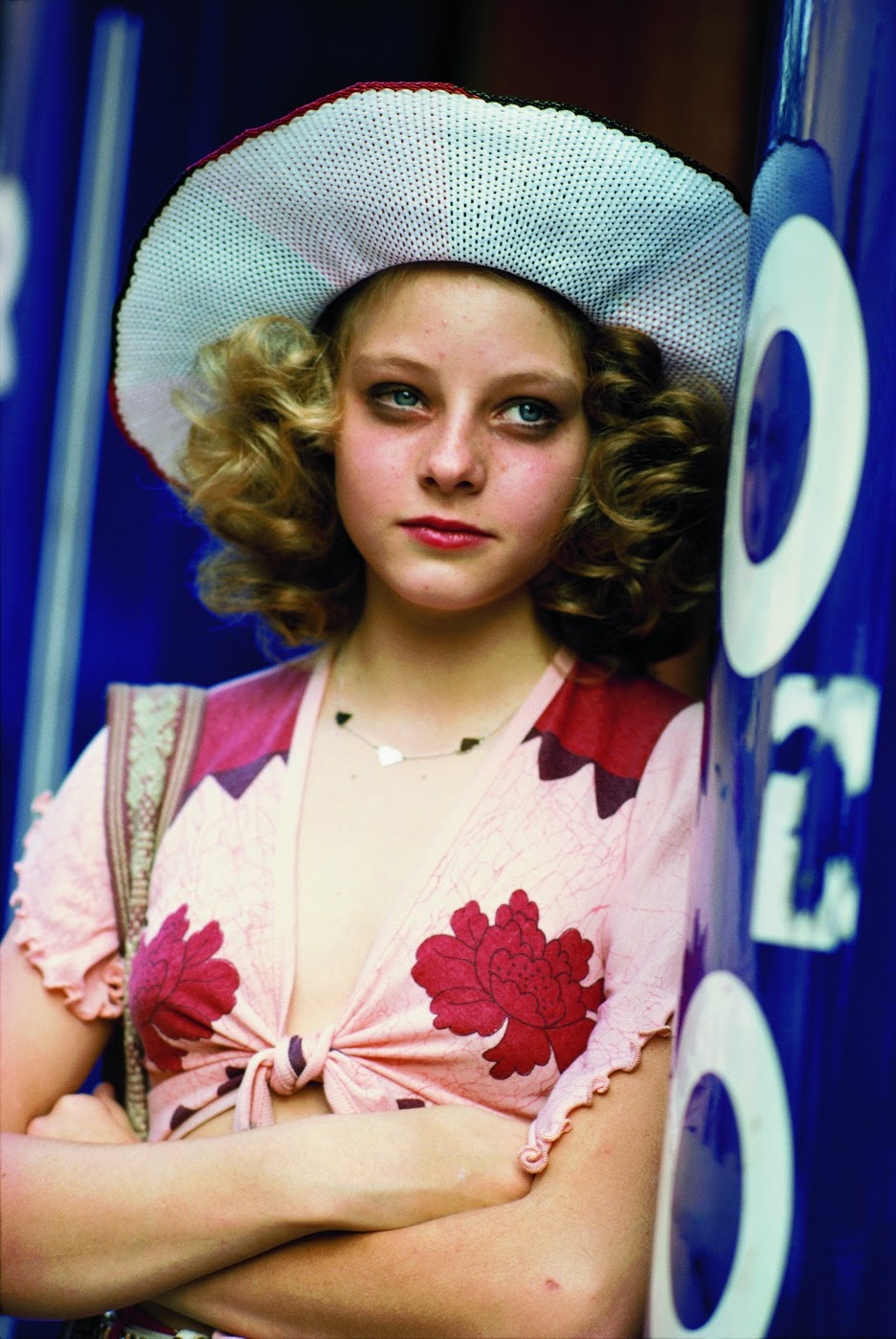 Taxi Driver’s undiminished power owes partially to Scorsese’s harnessing of Michael Johnson’s restless camerawork, with its ominous pans and tracking shots, and Bernard Herrmann’s insinuating sax-and-harp score (his last). Nothing was more important, though, than the jive of Paul Schrader’s voiceover for Robert De Niro as Travis and the kinetic rhythms of the stylised dialogue, some Schrader’s, some improvised, which flowed through the star, Harvey Keitel as the pimp Sport, and Jodie Foster as the 12-and-a-half-year-old Iris (pictured), whom Travis seeks to liberate from prostitution. It guided their body language - Travis is deliberate, Sport has a junkie’s jitters, Foster is a larky kid. (Cybill Shepherd as Betsy, the narcissistic, Beatrice-like campaign worker Travis stalks after she rejects him for taking her to a porno, is pleasing in a wholly different register.)
Taxi Driver’s undiminished power owes partially to Scorsese’s harnessing of Michael Johnson’s restless camerawork, with its ominous pans and tracking shots, and Bernard Herrmann’s insinuating sax-and-harp score (his last). Nothing was more important, though, than the jive of Paul Schrader’s voiceover for Robert De Niro as Travis and the kinetic rhythms of the stylised dialogue, some Schrader’s, some improvised, which flowed through the star, Harvey Keitel as the pimp Sport, and Jodie Foster as the 12-and-a-half-year-old Iris (pictured), whom Travis seeks to liberate from prostitution. It guided their body language - Travis is deliberate, Sport has a junkie’s jitters, Foster is a larky kid. (Cybill Shepherd as Betsy, the narcissistic, Beatrice-like campaign worker Travis stalks after she rejects him for taking her to a porno, is pleasing in a wholly different register.)
Haunted by John Ford’s The Searchers (1956) and the tormented racist Ethan Edwards’s redemptive quest to rescue his teenage niece from miscegenation with a Comanche chief, Schrader first updated it in Hardcore (1978), about a Dutch Calvinist furniture manufacturer wresting his daughter from LA pornographers, then used it as the basis for Taxi Driver. The latter film is more psychologically and socially complex. Traumatised by what he’s seen and done in Vietnam (though it’s not mentioned), paranoid and puritanical, Travis wills himself to take murderous Oedipal revenge on Betsy’s and Iris’s father figures: first, he escapes, unidentified, his attempted assassination of the presidential candidate who’s Betsy’s boss; then goes after Sport (Keitel, pictured below) and his cohorts, resulting in one of the bloodiest götterdämmerungs in Hollywood cinema up to that point. He thus becomes the tabloid hero who earns Betsy’s respect - or is that the dying fantasy of the wounded vigilante who sits on the whorehouse couch? - and the madman who should be treated in a high-security hospital. He is a purger who requires something more than purgation: how shocking it still is to see him pulling the trigger of the gun he has pressed to his head.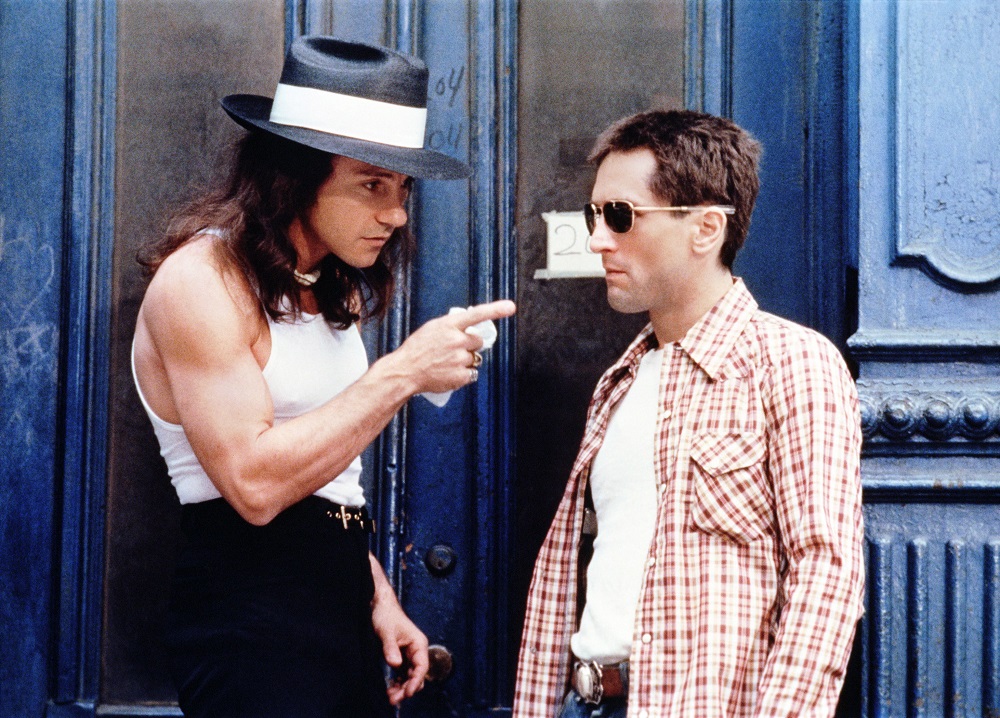 In 1981, Travis inspired John Hinckley Jr, who wanted to impress Foster, to try to assassinate President Reagan. Taxi Driver thus acquired an undeserved notoriety. Blaming the film as the root cause of Hinckley’s act is akin to blaming it for Arthur Bremer’s 1972 shooting of George Wallace (Schrader read Bremer’s diaries before writing the script) or for Samuel Byck’s assassination attempt on President Nixon in 1974 (Schrader says he based “Bickle” on a radio show called The Bickersons, not “Byck”), which generated the 2004 Sean Penn film The Assassination of Richard Nixon.
In 1981, Travis inspired John Hinckley Jr, who wanted to impress Foster, to try to assassinate President Reagan. Taxi Driver thus acquired an undeserved notoriety. Blaming the film as the root cause of Hinckley’s act is akin to blaming it for Arthur Bremer’s 1972 shooting of George Wallace (Schrader read Bremer’s diaries before writing the script) or for Samuel Byck’s assassination attempt on President Nixon in 1974 (Schrader says he based “Bickle” on a radio show called The Bickersons, not “Byck”), which generated the 2004 Sean Penn film The Assassination of Richard Nixon.
You could equally blame Travis for the shooting that killed six and left Congresswoman Gabrielle Giffords severely wounded this past January. It makes no sense; sociopaths invariably find excuses for their rage, but a cultural artefact cannot be held responsible. More pertinently, Travis, as a metaphor, was a caustic agent poured not just on rampant vice, and a society that sanctions it as a corrupt form of business, but on a political culture founded on empty rhetoric and the crime of sending men to die in capitalist wars of ideology. Assuming Travis didn’t die from his neck wound, I like to think he’s still hacking it on the New York streets, without the guns.
- Taxi Driver is on limited re-release in UK cinemas. Screening information on the Park Circus website
- Read more film reviews on theartsdesk
MARTIN SCORSESE ON THEARTSDESK
Shutter Island (2010). Not a blinder: Leonardo DiCaprio in Martin Scorsese's feverish paranoid thriller
Hugo (2011). Scorsese does a Spielberg in sumptuous look at the origins of cinema
George Harrison - Living in the Material World (2011). Martin Scorsese's epic documentary of the Quiet One
The Wolf of Wall Street (2014). Con brio: Scorsese and DiCaprio tell of the rise and fall of a broker
Arena: The 50 Year Argument (2014). A warmly engaging film about the 'New York Review of Books' might have been more than a birthday love-in
Vinyl (2016). Scorsese and Jagger's series is prone to warping, skipping and scratches
Silence (2016). Scorsese's latest is a mammoth, more ponderous than profound
Overleaf: watch the new trailer to Taxi Driver

There aren't many films that at (nearly) three hours in length leave you wanting more. But such is the hypnotic grip cast by Maren Ade's Oscar-nominated Toni Erdmann that its final image seems as much the prelude to something as a closing note on what has come before. A dark comedy about a father who risks destroying the daughter he also clearly loves, the movie rides multiple shifts in tone with remarkable ease.

Loving is not just a love story, it’s also the true story of Richard and Mildred Loving, a couple from Virginia who got married in 1958. Richard was white, Mildred was not, and because interracial marriage was banned in Virginia, they were both arrested under the anti-miscegenation laws.

Matthew McConaughey has already had a go at hunting for gold (on film, at any rate) in 2008's Fool's Gold, where he and Kate Hudson were on the trail of a sunken Spanish galleon full of treasure. Critics were unsympathetic ("excruciatingly lame" was a fairly typical response).

If Christine may occasionally be an uncomfortable film to watch, it’s impossible not to be gripped by Rebecca Hall’s sheer, virtuoso turn in the title role of Antonio Campos’ third feature: it sears itself on the memory with a pitiless rigour that won’t be easily forgetten.
Hall plays Christine Chubbuck, the Florida television presenter who shot herself in 1974 while live on air on the station for which she worked. If that’s a real-life act that’s (inevitably) impossible to follow, Craig Shilowich’s script and Campos’ direction open her story out to us with a fully convincing wider perspective, a story that combines talent with aloneness, insight with mental illness, and personal drive with a brittle everyday manner (when a colleague tells her, “You’re not always the most approachable person”, it’s an understatement).
Michael’s remedy is to apply an 'If it bleeds, it leads' news policy
It’s also a time that doesn’t accept assertiveness from a woman easily: when the channel’s boss Michael (Tracy Letts, sympathetic even when he’s driven to exasperation) accuses her of being a feminist, he means “always talking louder than the other guy”. It doesn’t help that revenues are down, for which Michael’s remedy is to apply an “If it bleeds, it leads” news policy, a headlines-chasing search at odds with the “issue-oriented” journalism that Christine advocates for her “Suncoast Digest” strand (but doesn’t always manage to find, Sarasota being something of a backwater, so she’s left covering plenty of local curiosity stories).
But if such a précis sounds dour, Christine isn’t. There’s plenty of humour in Shilowich’s script, not least in its depiction of how a news studio actually works: how long-ago it all seems now, with TV still shooting material on film, the move to video only just underway here. (Christine’s television world clearly recalls Sidney Lumet’s 1976 Network too, not least because that film is about a presenter threatening suicide on air: Network clearly absorbed elements of Chubbuck’s story, even if writer Paddy Chayefsky said that he’d started developing its script before her death.)
There’s a finely crafted sense of the dynamics of this small working company. Michael C Hall is the station’s anchor George, the good-looker on whom Christine has a crush – as weathercaster Steve pays hopeful but unrequited attention to her – but though a late scene shows him to be considerate to Christine, George is more caught up with “the little blonde number in Sports”, especially when the chance of a promotion to a larger station comes along. There’s real sensitivity from Maria Dizzia, who's superb as Jean, Christine’s immediate assistant (and camerawoman), whose intentions are all good but can’t keep up with the increasingly hyper tendencies that her boss (and friend) is showing (pictured below: Rebecca Hall).
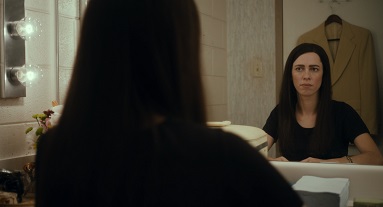 At home, that’s the problem also facing Christine's mother Peg (J. Smith-Cameron, a wonderfully sympathetic performance that has her trying so hard to do the best, but just unable to find the right keys to press). There’s clearly been a breakdown in the past, and Peg can spot the symptoms again – better than the doctor to whom Christine goes about another ailment that proves the source of new anxiety. The doctor is ready to offer, so characteristically for the Seventies, pills for the stress that Christine complains about all the time, without recognising the deeper channels of her mania.
At home, that’s the problem also facing Christine's mother Peg (J. Smith-Cameron, a wonderfully sympathetic performance that has her trying so hard to do the best, but just unable to find the right keys to press). There’s clearly been a breakdown in the past, and Peg can spot the symptoms again – better than the doctor to whom Christine goes about another ailment that proves the source of new anxiety. The doctor is ready to offer, so characteristically for the Seventies, pills for the stress that Christine complains about all the time, without recognising the deeper channels of her mania.
There’s so much more nuance than any retelling of the film's story can suggest. We see Christine not only when she’s struggling, but also when she's volunteering as a puppeteer at a local children's home, which reveals a different side to her. I have no idea if Shilowich drew that element from real life, or added it to his story, but it blurs our expectations beautifully – if we only saw Christine as a neurotic harridan, we would not be rooting for her, for things to turn out any other way than as they did.
Another element that strongly colours the film is its sense of period, specifically the months around President Nixon’s resignation in the aftermath of Watergate, an act that somehow forces America to confront a national neurosis that parallels that of Christine. Production design from Scott Kuzio catches a terrific sense of the moment, and it’s there to a tee in Emma Potter’s costumes, too, all the colours and the cuts. The outstanding technical achievements extend to sound design (Coll Anderson) that sways with Christine’s moods, alongside a score from Danny Bensi and Saunder Jurriaans that employs some glorious tracks of the time. It’s a lovely balance: we relish Christine singing along to pop as she drives around determinedly in her yellow Volkswagen Beetle every bit as much as we feel with her when she’s entering darkness.
It’s a five-star performance from Rebecca Hall that reveals whole new facets to the actress, whose omission from the Best Actress Oscar shortlist looks little short of perverse. It’s more than enough – not that there isn't a great deal else around to merit it – to swing a fifth star for the film itself, not least for the hope that director Antonio Campos delivers on its promise. The two films he made before were at the arthouse end of the spectrum, and we can only cheer that a studio (Universal) gave him the chance to make a film that gives – in the best, if now rather old-fashioned sense? – adult viewers an adult story, one that challenges. Christine may make demands, but how much more richly it repays them.
Overleaf: watch the trailer for Christine

After doing his time in the Hollywood wilderness, Mel Gibson is back with a bang – a cacophony of bangs, frankly – with Hacksaw Ridge. With six Oscar nominations including Best Director, Best Actor and Best Picture, it's enough to tempt a man to risk a celebratory tequila.

